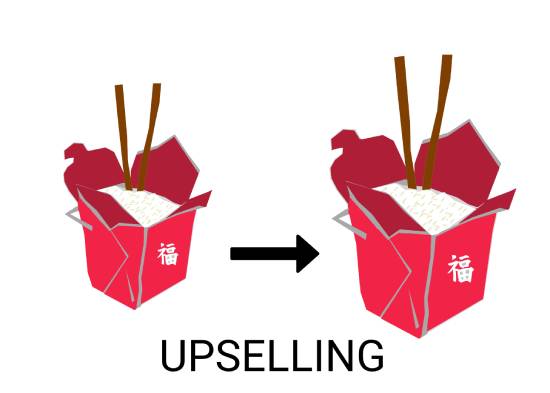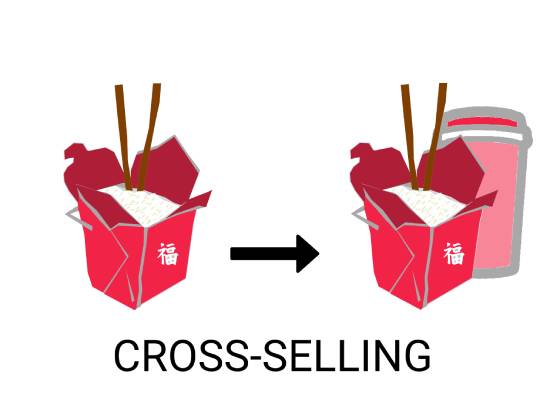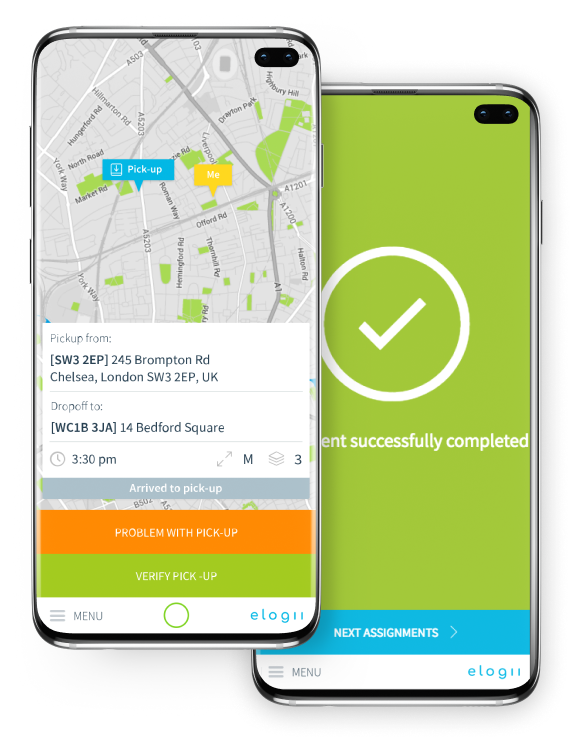How to Offer Free Delivery to Your Customers [in 2024]
How to offer free delivery to customers? How does Amazon do it? Explore step-by-step tactics to deliver orders for free even on a tight budget.
Home > Blog > Upselling & Cross-Selling with Delivery: Can It Be Done?
ConstructionIn this new post, we will show you how to start upselling and cross-selling with delivery. Whether it’s a myth? Or has it become a reality?
In this new post, we will show you how to start upselling and cross-selling with delivery.
Whether it’s a myth?
Or has it become a reality?
First, you will take a look at what does it mean to upsell a product, how does it work, and what makes it different from cross-selling.
And, how using both sales tactics benefits your business. (Regardless of the industry you are in)
Then, you’ll see why you should seriously consider upselling and cross-selling your products through delivery.
And how to make it a reality in your company, step by step.
Let’s start.
Upselling (or selling-up) is a valuable sales technique to boost profits. It means getting customers to buy the same type of product but at a higher price.
Usually, this is a larger, more feature-rich, or custom version of the product.
So, what is upselling exactly in a real-life situation?
“Would you like to upgrade to a large order?” is an example of upselling food delivery at restaurants and dark kitchens.

Cross-selling is a sales strategy that involves getting customers to spend more money on a different product that complements the initial purchase.
So, what is cross-selling exactly in a real-life situation?
“Would you like a drink to go with your meal?” would be a cross-selling example at the mentioned food delivery.

So, what is the difference between an upsell and a cross-sell?
An upsell is a different version of the same product.
And a cross-sell is a completely different product.
Now, let’s take a look at why you need to do it.
Creating upsell and cross-sell offers isn’t a new thing.
For years now, Amazon and other ecommerce stores have been using these tactics on product pages and at checkout:

Many other companies consciously create slightly different versions of the same product only to upsell them later.
Think of the difference between an iPhone series model and a Plus version.
The only advantage of a Plus model is the size (and maybe some minor add-ons), while the price is sometimes over $100 higher than the original.

Source gsmarena.com
And businesses tend to create offers that supplement the original, increasing the order value:
So it isn’t a question of whether upselling is better than cross-selling, or cross-selling better than upselling.
You should implement both because several key benefits can help you:
Upselling and cross-selling improve your ability to retain more customers because it helps to resolve their pains more efficiently by recommending better solutions.
Both work in tandem to improve the customer’s experience:
At the same time, it makes your company seem more knowledgeable in the eyes of your customers.
And according to a recent survey, that’s important.
Almost 80% of people feel a knowledgeable service is an important part of a good customer experience.
Upselling more expensive items or cross-selling additional goods raises the average value of each order.
So even with fewer sales, the price per order makes up for the difference in profit.
At the same time, this also boosts the lifetime value of your customers.
Selling a more expensive item to a one-time customer means you get the biggest margins from every sale.
Product recommendations like upsells and cross-sells drive more revenue.
In fact, research suggests that it accounts for 10-30% of eCommerce revenue.
And it’s a more cost-effective way to raise profit.
It provides much better returns on your lead generation and customer acquisition efforts since it raises the price per sale of every successful conversion.
Knowing how to compete with Amazon, Walmart, Google, Apple, and other retail giants relies on your ability to co-exist with them.
So, it stands to reason that replicating their tactics levels the playing field and helps keep you in the game.
Many small-to-medium businesses cross-sell and upsell with Shopify.
But adding such offers shouldn’t stop at checkout on your web store.
You should actively seek out new opportunities to raise your sales effectiveness. And doing it right on your customers’ doorstep is one such possibility.
Customers are more likely to decide on cross-sell or upsell offers during delivery.
This rests on at least a couple of things.
First, customers value human interaction.
If your delivery drivers make a good first impression, customers are willing to let their guard down, listen to your delivery agents, and trust what they have to say.
As a result, customers are far more prepared to buy into a cross-sell or upsell pitch, especially if the delivery agent is capable of closing a sale.
The other reason why cross-selling and upselling during delivery works is because you offer it when the customer has already made a purchase.
On the one hand, the hardest part is over.
You have completed the sale, the customer has paid, and now he no longer has any objections about doing business with your company.
If your delivery agent comes to the customer with a superior product at a slightly higher price or a different product that instantly raises the value of their purchase, he will be inclined to consider the new offer.
And when the customer weighs the difference in cost against the benefits of the new purchase, they seem many times lower than when he compares two products at checkout.
This makes your customers far more likely to accept upsell or cross-sell offers during delivery.
It’s also one of the main reasons cross-selling and upselling through delivery is one of the new trends in delivery management in 2020.
Now, let’s take a look at how you can do it.
In this section, you’ll see how to get started with upselling and cross-selling products through delivery.
We’ll walk you through key factors that affect upsell and cross-sell offers.
Not to mention, how to handle inventory and operations, and how to execute all of these tactics to perfection.
In the end, you’ll have a better understanding of how to get it done, step by step. Here’s what you need to do:
Effective upselling and cross-selling is all about timing.
If the timing is off, you risk upsetting your customers, since 40% of people are aware of these sales tactics.
So, first thing first, you need to decide:
Once you have a clear strategy when you want to offer upsells and cross-sells, you now have to decide what they are.
And while your offer could include the entire product catalogue, it’s best to do some testing first.
With upselling, start with your best-sellers and move forward from there.
If your customers are stuck on those products, try recommending that they buy two or more of them at a discount.
With cross-selling, start matching different accessories to corresponding products.
For example, if you operate a beverage delivery, you can start to cross-sell pints with variety 12-packs, or taps with draught beer.
After a certain period, you can change the offers and move on to test your other products.
When creating upsell and cross-sell offers, it’s critical to take some time to evaluate consumer data.
This might be useful for several reasons.
First, it helps you identify the right customers for the pitch.
Targeting returning customers might prove more lucrative since they have a history of doing business with your delivery.
In fact, according to Marketing Metrics, the authors point out that:
“The probability of selling to a new prospect is 5-20%. The probability of selling to an existing customer is 60-70%.”

Source: Groove
You can also use data to track movement on your website, including purchase trends.
This can help you to detect key products your customers consider before checkout, which may be a good upsell or cross-sell opportunity.
Without the ability to track and monitor orders and compare them to stock, depots get depleted quickly.
Drivers end up leaving for their routes with empty vans.
And they miss out on a chance to pitch offers to customers.
So before you start upselling and cross-selling through delivery, you need to adjust the supply chain and align it with your inventory.
This will allow you to maintain stock even when demand exceeds your capacity.
First, you will either have to increase the supply orders, the supply order frequency, or the rate of production.
So you will need to consolidate all of your supply vendors to efficiently manage storage, as well.
At the same time, you will also have to evaluate key sites in the supply chain network.
This means choosing between single depot vs. multi-depot planning.
Once you cover all of these points, you stock your vehicles full of products.
So not only will your drivers be able to upsell and cross-sell products, but you will be one step closer to building an agile delivery operation with storage on wheels to boot.
As mentioned, analyzing data helps you create better upsell and cross-sell offers.
But collecting customer data helps your drivers seal the deal at the door, as well.
Using a driver app gives drivers access to vital customer information.
They can use that data to craft a personalized sales pitch and persuade customers to buy the upsell or cross-sell product.

But this still might not be enough to close a sale.
So, you should free up some resources to train your delivery agents in successful sales tactics, or start hiring solid drivers with a background in sales.
Upselling and cross-selling products during delivery depends on full control and visibility over every part of your operation.
From the moment a customer checks out his purchase, to when a driver pitches the new product at his door, you need to have insight into every task and process before your drivers can start closing deals.
That requires a holistic approach to delivery management.
So, relying on a host of disconnected apps can’t cut it. Instead, you have to integrate an end-to-end solution, like delivery management software.
Taking a platform approach to delivery management lets you plan, manage and review orders, supplies, inventory, and the fulfilment process all on one dashboard.
Software solutions like these use APIs to integrate with any other system or app, like your website or your Shopify account.
This makes it easier for you to build on what you have, and upsell or cross-sell both online and live.
The tool can seamlessly handle dozens of tasks, orders, deliveries, vehicles, fleets, drivers, teams, and routes, all the while optimizing each part of the operation for maximum efficiency.
This means drivers spend less time focusing on how to get to your customer, and more time on how to best sell them your products.
Plus, delivery management software offers other great features as well:
Are you ready to start with upselling and cross-selling to customers with delivery?
Remember, successful upsells and cross-sells are all about good timing.
Don’t get us wrong. You should offer better deals, extra items, and useful add-ons on your website to motivate customers to spend more money.
But with product recommendations at the customers’ door, it will be easier to pitch the right upsells and cross-sells at the right time and to the right customer who will act on that offer.
So what do you think?
Is it time to start upselling products to customers during delivery?
Or do you have the ideal product to cross-sell with a bestseller?
To help you get started, we have a great offer.
We have everything you need to start improving your delivery.
How to offer free delivery to customers? How does Amazon do it? Explore step-by-step tactics to deliver orders for free even on a tight budget.
Want to raise sales by 56%? This guide will show you EXACTLY how to do it using delivery optimization, step-by-step. Plus what software to use to do...
How to offer same-day delivery to customers? The secret: delivery software. Learn how to deliver purchases to customers on the same day they order...
Be the first to know when new articles are released. eLogii has a market-leading blog and resources centre designed specifically to help business across countless distribution and field-services sub sectors worldwide to succeed with actionable content and tips.
